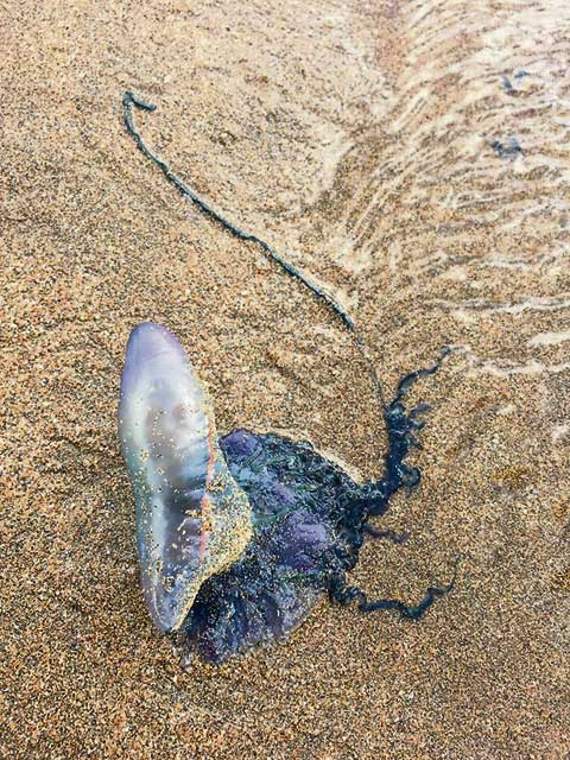THERE have been warnings circulating across the country, after the biggest number of sightings of ‘Portuguese Man O’War’ in years has been recorded — with some of the jellyfish-like creatures being spotted in and around Bude.
The fascinating creatures, which have a distinct similarity and appearance to that of a jellyfish, are colourful and can give a very painful and harmful sting, triggering warnings to ‘look, not touch’ across the nation — particularly in Cornish coastal communities.
People in and around Bude have been posting their very own warnings to social media pages, with the creatures having been spotted from Summerleaze to Northcott and Blackrock beaches.
Portuguese Man O’War — otherwise known by its scientific name, Physalia physalis — is a floating colony of hydrozoans, made up of lots of tiny organisms living together and behaving as one animal, leading people to often mistake the creature for a unusual-looking jellyfish. They are a species of siphonophore, comprised of a colony of zooids, all with various forms and functions, working together as one.
Their sting, located in their long, royal blue-coloured polyps, is extremely painful and can be lethal, with some deaths having been recorded in other parts of the world but not, as far as it is known, in the UK. They are recognised for their peculiar balloon-like top, which can be blue, violet or pink in colour.
Portuguese Man O’War are not naturally supposed to be in our waters, but with the chaos of the weather, they get blown in and ultimately find themselves washed up on the beaches, Dr Peter Richardson from the Marine Conservation Society told the Post last year, after a number of the creatures flocked to Cornwall’s shores similarly in 2016.
James Wright, curator at the National Marine Aquarium, said: “The Portuguese Man O’War, which has the appearance of a jellyfish, is usually found in warmer Mediterranean waters but, due to tidal behaviour, has been spotted on our local coasts. This species of jellyfish has a very strong sting, which is particularly hazardous for anyone who is susceptible to more severe reactions to stings from other species, such as bees.”
The Marine Conservation Society is urging people to not touch the creatures, as they can ‘deliver a powerful punch’. They have described this year’s sightings as the ‘biggest for years’ — since 2012, according to Dr Richardson.
The society has received reports from Sennen to Port Isaac, and is now hearing reports of strandings around the North Devon coast, up to Woolacombe and Saunton.
According to the society, 2017 is the second consecutive year that the creatures have turned up in numbers.
Dr Richardson said: “It’s the tentacle-like polyps that can give an agonising and potentially lethal sting. Because a stranded Portuguese Man O’War looks a bit like a deflating purple balloon with blue ribbons attached, children will find it fascinating.”
He added that it is important for people to be aware of their appearance and that people should not touch them if seen.
“The sting can be unbelievably painful and, in rare cases, fatal. We’d like people to report any sightings of Portuguese Man O’War to our website so we get a better idea of the extent of the strandings.”
Mr Wright added: “Our advice for anyone visiting local beaches is to be cautious if you are considering swimming in the sea at this time of year, and under no circumstances touch any jellyfish, or anything that looks like a jellyfish, washed up on shore.
“Even if the jellyfish appears to be dead, it can still eject a powerful sting, due to involuntary reaction caused when proteins, such as on your fingers, touch the jellyfish membrane. If anyone has been stung, they should seek immediate medical attention.”
People who spot Portuguese Man O’War should report the sighting to the Marine Conservation Society, by visiting the website www.mcsuk.org, where further information on the creatures can be found.




.jpeg?width=209&height=140&crop=209:145,smart&quality=75)
Comments
This article has no comments yet. Be the first to leave a comment.